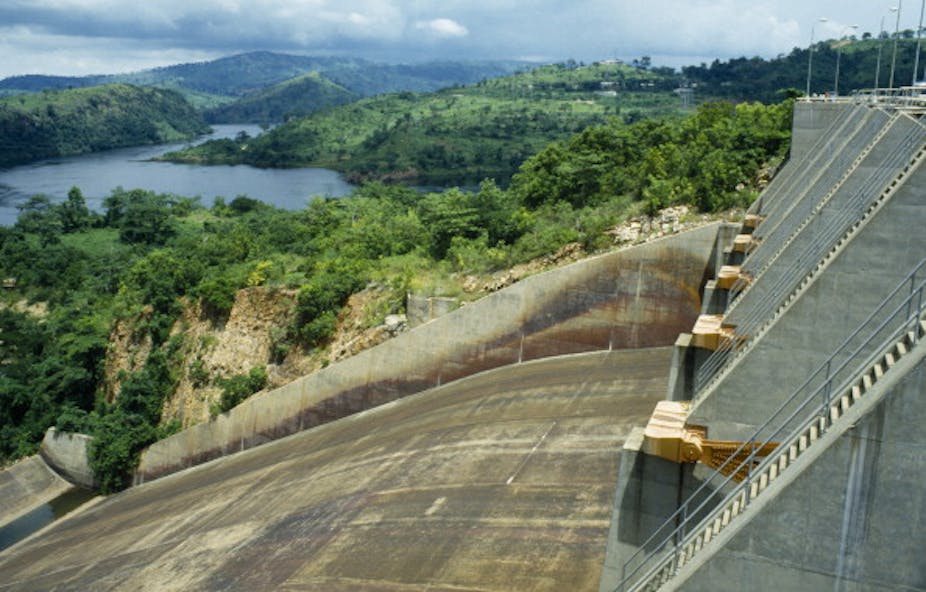Recent heavy downpours in the Lower Volta area of Ghana led to the worst flooding in the region’s history. The flooding was caused by a spillage (a deliberate release of water) from the Akosombo Dam, the country’s biggest hydroelectric dam. Over 26,000 people were displaced. No deaths have been officially announced. The last recorded spillage was in 2010.
The Volta River Authority, the state agency that manages the Akosombo Dam, opened the flood gates to release pressure on the dam after unusually high rainfall. By September, Volta Lake, the vast, 400km-long reservoir behind Akosombo Dam, had been filled to capacity. A month after the spillage started, communities along the Volta River were severely affected by the excess water.
Local residents fled to safety, leaving behind most of their belongings. Farms were submerged and crops destroyed. The inventory of stores and businesses in low-lying areas suffered extensive damage.
The director of the disaster management organisation was quoted as saying that the floods were caused by heavy rains in the Volta catchment basin. Climate change and global warming, he explained, were responsible for all the water coming down the Volta.
Other factors are relevant too to understand this crisis. Based on my knowledge of the area as a historian who has studied the Akosombo Dam and its impact on the lives of the people in the Lower Volta, I would attribute the extent of the calamity to two additional factors.
One is the ecological and economic changes brought by the construction of the Akosombo Dam. The areas affected by the flooding have been populated by farmers who settled there after they could no longer farm and fish elsewhere in the Lower Volta once the dam was built. The second is the failings of the Volta River Authority which manages the dam.
The history
The Lower Volta lies below the country’s two large hydroelectric dams, Akosombo, completed in 1965, and Kpong, completed in 1982.
The Volta River Project was Ghana’s largest development project. It included Akosombo Dam and an aluminum smelter as the dam’s main beneficiary. Even in the 1950s the planners of the project recognised that damming the Volta would have severe economic effects on the Lower Volta. There was also recognition that the project would lead to major ecological changes.
In its 1956 report, the preparatory commission, which closely studied the Volta River Project, detailed the changes that were to come.
The first was that the construction of the dam would put an end to the ecological cycle that had nourished the Lower Volta for centuries. The area was accustomed to substantial annual floods that filled hundreds of small creeks, fertilised agricultural lands and created large fisheries. The cycle of annual floods enabled a prosperous agricultural society with farming, fishing and clam picking (which was largely done by women.)
During the dry season, men migrated upstream to fish, hunt, farm and build boats.
Once Akosombo was built, the annual floods stopped. The dam created a regulated river downstream.
The preparatory commission warned about the radical changes the dam would bring downstream. But policymakers and Ghana’s governments ignored them.
The impact on communities of the Lower Volta has been examined by researcher Dzodzi Tsikata in her study Living in the Shadow of the Large Dams. In response to the dam being built many people migrated upstream and formed the fishing communities that now populate the shores of Volta Lake. Those who stayed and continued farming had to adapt their agricultural practices by planting in low-lying areas closer to the Volta River.
Subsequently, settlements expanded into the former flood plains along the river. These areas have now been inundated by the flooding caused by the spillage at Akosombo.

Woeful response
The current flooding raises the question of who is responsible and who must compensate those who have been affected.
According to the 1961 Volta River Development Act (Act 46), the Volta River Authority has a statutory responsibility to prevent Volta Lake from rising to a height of 85.3 metres above sea level and cresting the dam.
In addition, the Volta River Authority should prevent the “flow of water past the dam” from causing “flooding downstream from dam above the levels which were normal” prior to the construction of Akosombo.
Finally, the authority has to “take reasonable measures to give warning of possible flooding from the lake or from the River Volta downstream from the dam.”
The Volta River Authority preserved the integrity of the Akosombo Dam by opening the floodgates and spilling the lake’s excess water. But it failed in its other tasks.
It did not maintain an unoccupied flood zone which could absorb the excess water.
It failed to give people a timely warning to evacuate. The managers of the dam organised a simulation exercise for surrounding communities in May 2023.
It did not help people in the flood zones to move out of danger with their belongings.
In my view, the Volta River Authority, and by extension the Ghanaian state, have a moral obligation to compensate the people affected by the spillage and the subsequent floods.
Although the authority has income through the sale of electricity, it operated at a loss in 2022, due to increased administrative expenses triggered by inflation. The Ghanaian state is also facing deficits. So there is little certainty about whether the residents of the Lower Volta will receive compensation.
One would hope that the Volta River Authority and the Ghanaian state would finally address some of the historical injustice experienced by the communities in the Lower Volta since the early 1960s.

